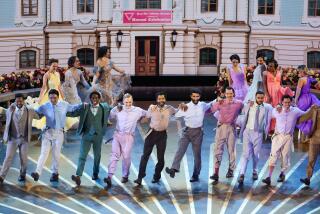Every Movement Tells the Story : Dance: Performer of classic Indian dance Sonal Mansing will bring mythological characters to life in her first local presentation.
- Share via
RANCHO PENASQUITOS — Playful gods, evil demons and cavorting animals will emerge this weekend from a single source--the animated body of Sonal Mansing.
The performance will showcase two obscure dance styles from India, called Bharata Natyam and Odissi, that abound with the lively mythological characters.
Mansing has been an exponent of classical Indian dance for 30 years, but this solo concert--at 7 p.m. Sunday at Mt. Carmel High School--marks her first local appearance with the dances that date back to the religious and ritualistic temple dances of South India.
Westerners often discount Indian dance as a visual art rather than a kinetic one. Mansing, however, disagrees with that.
“I believe people think it’s static because they have seen mediocre dancers,” she said in a phone interview last week from the Bay Area. “There is so much filigree in Indian movement--the body moves, the eyebrows, the nostrils, even the mouth and fingertips. We just don’t try to defy space all the time.
“There are two elements in Indian classical dance. One is pure dance--abstract dance--with body posturing and cross-rhythms to embellish space and derive pleasure from the melodic content. The second is, I think, unique in the world history of dance.
“It’s a communication, and that is misconceived” by Western audiences, she said. “It has literature spoken by the singer, and the body posturing speaks its own language. So there is a lot of movement, but unless you are prepared, you can’t follow the story.”
To keep her audiences on the right wavelength, the New Delhi native explains the codified movements and gestures called madras that evoke the heroes and villains in her dance dramas. The narrative is woven through her performance--even in India.
Although Indian classical dance is firmly rooted in Hindu philosophy and devotion, the dancer finds freedom of expression within the basic tenets.
“It’s like a grammar,” she said. “Each dancer produces her own poetry. The beauty is you can pick up any piece of literature, and cross-pollinate. I even took poems from Goethe when I was in Germany and used that in a dance.”
For Sunday’s performance, Mansing will invoke the 10 incarnations of the Lord Vishna and give her own version of a popular bedtime story about a clever crow--a fairy tale that shows up in every region of India.
There will be no live music or chanting to accompany her solo performance. Mansing’s animated figure will be adorned with traditional Indian ornamentation and dramatic makeup as she pounds out the complex rhythms with her bare feet and curls into the sinewy shapes of its exotic movements.
“We don’t have costume changes for every character,” she said. “That’s the fourth dimension of Indian dance. (The dancer) brings out the atmosphere, the mood, the distillation of the story. We internalize it, and then give out the essence.”
More to Read
The biggest entertainment stories
Get our big stories about Hollywood, film, television, music, arts, culture and more right in your inbox as soon as they publish.
You may occasionally receive promotional content from the Los Angeles Times.








